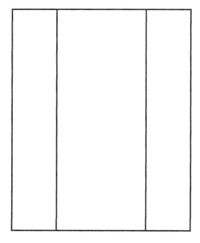Your Quilt is not complete without a Backing
When shopping for quilt backing, most people will purchase inexpensive fabric or plain muslin. This is fine as long as it is good quality fabric. You don’t want the back of your quilt to wear out long before the top. Remember that sometimes the backing will show if it gets flipped over or scrunched somehow. So, consider choosing a backing that co-ordinates with the top of the quilt. Avoid the temptation to purchase a sheet for your quilt backing. The results are unpredictable when quilting sheets. The higher thread count causes needles to become duller faster and sheets do not heal like quilting fabric.
How to piece your quilt backing. It is possible to purchase extra wide fabric made especially for the purpose of quilt backing. This is a great choice that saves you time because you don’t have to sew long pieces together. Or, if you’re a hand quilter, you don’t have any extra seams to sew through. If you cannot find extra wide backing fabric that co-ordinates with your quilt, then you will purchase enough quilting cotton that when sewn together it is big enough for your quilt.
When sewing 44” fabric together for the back, rather than make just one seam down the center of the back, it is best to put one full width of the fabric down the center, and add two narrower widths down each side as shown below.

The reason for this is that a quilt gets most of its wear down the center and a seam there will wear faster. Also it is more comfortable if you are snuggling under a quilt, to NOT have the seam down the middle.
Two full side panels would not be necessary for a quilt that is 60” wide. By using one 44” panel and one 20” panel, the seam will be offset from center.
How to figure out how much fabric you need to purchase for your quilt backing: The back of your quilt should be about 3-4” larger all around than the top of the quilt. I usually measure the length of the quilt and add 8”, and then measure the width and add 8”. If the quilt is wider than the normal 45” fabric (it is also a good idea to measure the exact width of the fabric you are purchasing as widths vary from 40-45”), then you will need two lengths, ie if your quilt top is 70×85, add 8” each way making it 78×93, then you will need 93” times two, or 186”. I would purchase 4.8 m (186″ divided by 39″ for meters).
You can also make a horizontal seam on the back. This means if the length of your top, plus the 4” top and bottom, adds up to less than 90″ (45”x2) then you could use two widths of fabric. Measure the width plus 8” and purchase two times this number.
Some quilters also like to piece the quilt backing, using the left over fabric from the front. It can be squares or strips or whatever you want to create. If you are piecing and adding border strips to the backing, the strips added should be at least 3” wide. Having a large number to seams close together makes it difficult to center the quilt top while avoiding seams (seams that the machine quilter must quilt over and you will need to trim away before binding).